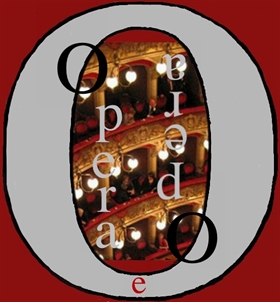IL TROVATORE in Genoa – Recensione di Neco Verbis – Violeta Urmana, Azucena, the most interesting staged in the new production of Carlo Felice –
Leave, go to Genoa (weather permitting) especially to see the premiere of Il Trovatore, at the Carlo Felice, on 22 November 2019, new production.
First you read the poster and, apart from the cast, you noted: "There is even the Master of Arms! Wonder! Then they will have swords and daggers, not the usual WWII rifles and pistols!” A milestone that pushes you even faster to the theater.

The Carlo Felice is beautiful, with its starry roof! You have read the poster, you have expressed some perplexity in your heart, but you are waiting confidently for the curtain to rise. We are also live streaming. The ladies are abuzz, but the cameras are only pointing at the stage.
Darkness, orchestra that tunes, here is Maestro Andrea Battistoni. One gets the impression that this conductor is growing up in Genoa, inside the mystical gulf of the theatre, as if he were in an incubator: he is now about thirty years old, but you can see and hear him directing there from his cradle. He will have improved the technique! Think and hope.
Orchestra lined up, attack, immediate opening of the curtain. "Nice!" – think – “The scene is revolving, like that of Carmen at the Met!”.

Gloomy atmosphere, everything is spinning, Ferrando enters…And from there, while the artists and the choir sing, everything happens, not excluding the torture and hanging of an anonymous prisoner, with the pricking of the hanged man with spears. The director Marina Bianchi indulged herself. You are bewildered and you listen to Ferrando by the good Mariano Buccino with an eye more to the stage movements than your ears pricked to the music.
The sets are beautiful, with the appropriate dark and severe costumes, both by Sofia Tasmagambetova and Pavel Dragunov, all also well lit by Luciano Novelli, but why overdo it, then, when you have props of this level? You ask regretfully, because what happens inside is sometimes comparable to certain cartoons by Jacovitti: even in the last act, you see the skeleton of a prisoner in a hanging basket, hanging like a ham only bones, on Azucena's head and of the Troubadour.

Azucena, in fact: the great Violeta Urmana, who, despite her many years of career, is the best on stage. But because she has an interpretative power and a respectable big voice, otherwise she would be suffocated by the overall clamor of the orchestra, for the entire duration of the work. All loud and fortissimo, which also forces the singers to sing all loud and fortissimo.

For Violeta Urmana, with an irrepressible physicality, there is no problem with her voice: she would drown out the noise of a jet. But for Vittoria Yeo, Leonora, despite a respectable volume, the feat is perhaps a bit’ more arduous; however probably comfortable, because her voice, rather angular and at times waning in the attacks, does not like and does not practice mezza voci and yarns. So they practically didn't hear about it. The interpretation was also scholastic, not very expressive.

Il Trovatore Marco Berti extricated himself more or less honorably, but he possesses neither particular vocal qualities nor a physicality that fills the scene. A voice and a figure that defining anonymous is perhaps the most correct term, despite the high-pitched ending achieved by Pira, but which had dropped in tone. The only notable thing was the support on the legs: a meter between one foot and the other. But then again, technically, you stand firmer to assist the diaphragm.

The Count of Luna Massimo Cavalletti was committed to expressing as much elegance as possible, both vocally and scenically, but his voice has problems in the low notes, which were almost blown out and, despite having cast more than one eye on the scenic nature of the great Zancanaro, it was a Count di Luna, immature and not very authoritative. He will probably grow up, we hope.

Overall volume stratospheric, it was said, Choir, instructed by Francesco Aliberti, adequate. This Genoese Trovatore was a roar, with an orchestra that was at times careless in its attacks and a conductor who, as usual, raged even with flat dynamics.
And the master of arms? But he was there too: Corrado Tomaselli! The setting of the opera was "regular" (even if moved more or less a century ahead) and some duels with swords, some training skirmishes and the wounding of Manrico at the end of the first act were mentioned.

Warm final applause for the production as a whole; Cavalletti received the most applause, the protagonist in the title role and Yeo received less celebration. But overall people liked it.
Probably also because finally the scene, which the director had compared to the unfolding of a fiction, without interruption between one scene and another, had stopped and the ears began to rest. But you go out to the theater and think: "But now do dramas persecute us in the theater too?"
Neco Verbis ©
PHOTOS © Marcello Orselli, Paolo Mazzaron, Tomaso Matta, Stefano Pischiutta, Teatro Carlo Felice

